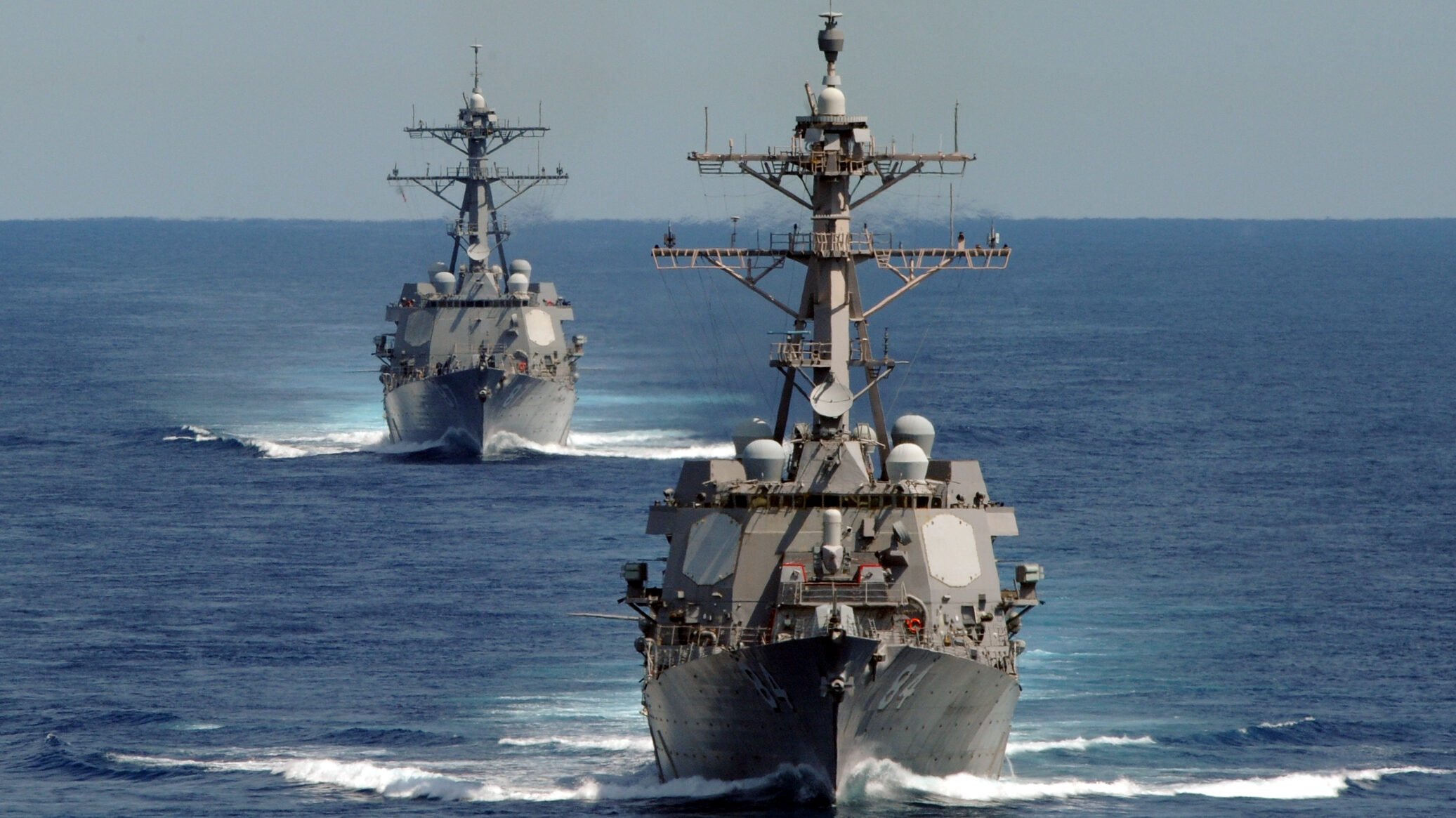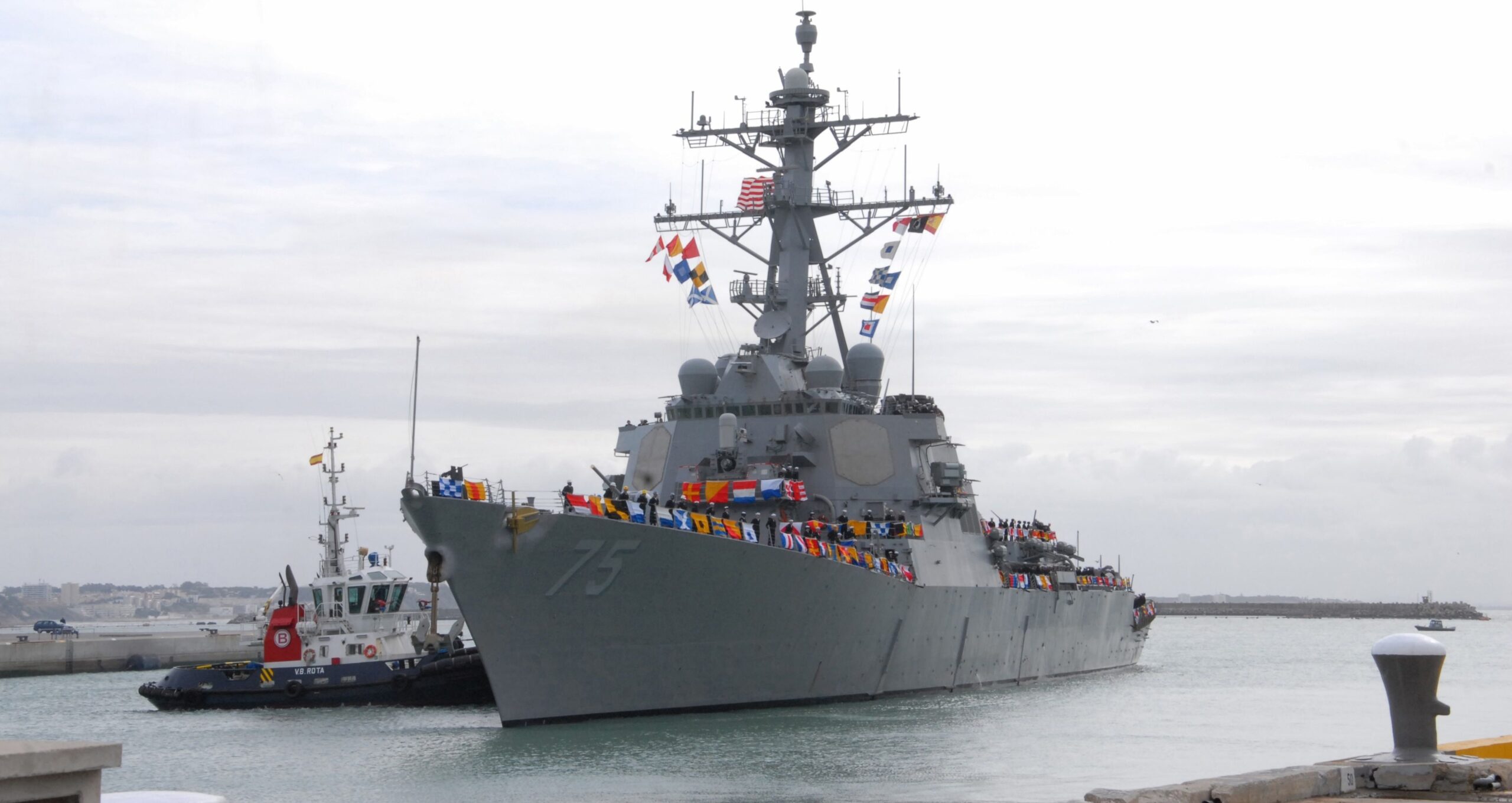
The Arleigh Burke-class guided-missile destroyers USS Bulkeley, right, and USS Mason participate in a strait transit exercise. (U.S. Navy photo by Seaman Jared M. King)
NEW YORK: President Joe Biden’s unexpected announcement this week that he will permanently station two additional Navy destroyers forward to Rota, Spain has won rare applause from Republicans in Congress, even as experts are warning that there may be unexpected complications to having those two ships forward deployed.
“Great news,” Sen. Jim Inhofe, R-Okla., the top Republican on the Senate Armed Services Committee, tweeted. The panel’s Republicans and “I have been calling for the U.S. to boost our destroyer fleet in Rota for years. This enhanced presence will strengthen our posture and deterrence capabilities in Europe.”
Although the two destroyers will not arrive until fiscal 2024, the increased US presence in Europe during a time of instability driven by Russia’s war in Ukraine is significant both symbolically and practically, experts tell Breaking Defense. But they also say the move will come with many questions, from balancing the Navy’s operational commitments elsewhere to preparing the service’s overseas maintenance facilities for a larger workload.
“This is a powerful signal that the US is in full support of beefing up [our] force posture in Europe,” said Jim Townsend, a senior fellow at the Center for New American Security. “That it’s not just China that drives our force posture overseas, it reassures allies that we are in the game and not just trying to get by on the cheap.”
The Only Ones Forward
The Navy’s presence in Rota and the increase of just two ships is such a powerful move because of the service’s unique ability to homeport its warships forward.
“The four, now six DDGs in Rota are an asset, a strong symbol of rotating forward presence — the [US Navy] still being the only Navy in the world to be forward present like that,” said Sebastian Bruns, a researcher at the Institute for Security Policy at Kiel University and formerly a visiting professor at the US Naval Academy.
Bruns and others emphasized that more ships in Rota translates to more engagements and exercises with European navies, which in turn leads to both Americans and Europeans understanding “the fundamental role of these ships as steel-gray symbols of American commitment to national and NATO interests,” as Bruns put it.
None of this is to say the ships already homeported at Rota are being left to enjoy the Spanish beaches. That original force first made its way to Europe in early 2014, forming what NATO dubbed the “centerpiece” of the alliance’s ballistic missile defense capabilities.
Townsend, the CNAS fellow who also spent eight years inside the Pentagon working on European and NATO policy, said those ships have been “really busy” getting buzzed by Russian pilots during patrol missions in the Baltics and the Black Sea.

The destroyer USS Cook arrives in Rota, Spain. (U.S. Navy photo by Morgan Over)
“With the invasion [of Ukraine], the Navy has upped its game in Europe,” Townsend said. “I’m sure there was a fight about that too between the Europe and Asia hands in both the Navy” and the broader federal government.
And it’s that conflict between commitments to Europe or Asia where the camaraderie among allies ends, and difficult choices between competing factions of the Pentagon begin.
“The argument we will hear against this move is that it takes away from the Indo-Pacific. Our national strategy says that Russia is an acute threat, but China is our pacing threat,” said Steven Horrell, a fellow at the Center for European Policy Analysis. “We cannot choose one region as ‘on’ and another region as ‘off.’ We have to walk and chew gum at the same time, as [Defense Secretary Lloyd] Austin recently said.”
More choices, more problems
Back on Capitol Hill, Biden’s announcement won applause not just from Inhofe, but the senator seen as a likely favorite to replace him as the top Republican on the Senate Armed Services Committee.
“Expanding our naval presence in Rota will send a strong signal of assurance to our allies in Europe,” Sen. Roger Wicker, R-Miss., said. “America is the world’s foremost seapower, and it is good to see the president has heeded calls from Congress to make force posture decisions reflecting that fact.”
Increasing the number of ships at Rota has a been a subject of ongoing debate for lawmakers in recent years, regularly stirring questions for the relevant general officers who go to the congressional panel for confirmation to new billets. The answers given by two relatively recent nominees offer a glimpse into the arguments likely happening inside the Pentagon.

Sen. Roger Wicker, R-Miss., who applauded Biden’s announcement, is seen as a likely candidate to be the top Republican on the Senate Armed Services Committee with Sen. Jim Inhofe, R-Okla., retires.
When asked in May whether he would support additional warships in Rota, Gen. Christopher Cavoli, now the Supreme Allied Commander-Europe, said the ships’ presence would be “beneficial” to the region, citing the need to monitor Russia’s activity in the Mediterranean.
But back in 2019, when asked a similar question, Chief of Naval Operations Adm. Michael Gilday said while he “agreed in principle” with previous US European Command chiefs that a greater Navy presence in the region would be positive, he also argued that it “must be balanced against other competing concerns including standing force structure, material readiness and preparation for high-end warfighting.”
To put it another way, combatant commanders like Cavoli view additional warships under their purview as the best way to reduce risk in their areas of responsibility. Less risk means less instability, and no COCOM will turn that down.
But from Gilday’s perspective, all the COCOMs want more ships, more subs, more of pretty much anything that is on offer from the service chiefs. Therein lies the uphill struggle of convincing the Pentagon and White House to commit to the additional destroyers. Every two ships you send to Spain, are two ships you cannot send elsewhere — like the Indo-Pacific where they could counter China.
In fairness to Gilday, his comments came before Russia’s latest invasion of Ukraine, in a very different geostrategic environment. But the contrast between the admiral and general’s remarks are only one example of the never-ending push and pull for resources between the service chiefs and the combatant commanders.
For every official inside the Pentagon arguing there is a need to help stabilize Europe in the wake of Russian aggression, there is another who could present a convincing case that the US still lacks the dominance it seeks in the Indo-Pacific.
“The need for greater naval presence is actually higher in Asia,” Brent Sadler, a fellow at the Heritage Foundation, contended. “A return to North Korean provocations. Russia’s Pacific fleet is again very active and most importantly China’s very large maritime force is flexing its muscles.”
“Bottom line, the two ships would have been better based in Asia where the looming danger of the next crisis largest,” he added.
And there is not clear agreement on the Hill about where those assets should be going, either. After the announcement, Sen. Marco Rubio, R-Fla., tweeted “Why is Biden sending more troops, planes & ships to Europe instead of the Pacific? Russia’s military is in no condition to invade anyone else right now and its China & North Korea who are threatening military aggression.”
A Problem at Home & Abroad
Another problem to consider is one that has historically plagued the Navy at home in recent years: maintenance.
“Overseas maintenance costs can be more expensive but ships may require less maintenance since they have less mileage on them than do US-based ships” said Steven Wills, a Navy strategy and policy expert with CNA, a federally funded research and development center that provides advice to the Pentagon.
“As always, the analogy here is like driving your car beyond the mileage recommended to bring it back to the dealer for maintenance. Lower mileage warships, like low mileage cars, are less likely to have breakdowns,” he continued.
While not quite as exciting an issue as potentially sailing alongside NATO partners, ship maintenance has been a pervasive issue for the US Navy at home where, relative to foreign ports, the service has every advantage for getting things right.
As the Navy prepares for the ships’ arrival in Spain in FY24, Rota’s maintenance facilities and capacity are likely to come under a microscope by the Pentagon and lawmakers to ensure the greater workload won’t cause delays.
In the meantime, expect service chiefs, combatant commanders, lawmakers and outside analysts to conclude with this thought when it comes to balancing all these competing priorities: It would all be a lot easier to make these decisions if only the US had more ships.
“The fact that two ships to Rota, Spain, could be disruptive to our capabilities and capacity in the Indo Pacific really says that the fleet size is too small,” said Horrell. “The ideal fix is not to perfect global force management — it’s to get budgets and shipbuilding plans where this isn’t a global force management crisis.”
Northrop sees F-16 IVEWS, IBCS as ‘multibillion dollar’ international sales drivers
In addition, CEO Kathy Warden says the company sees a chance to sell up to five Triton UAVs to the NATO alliance.


























